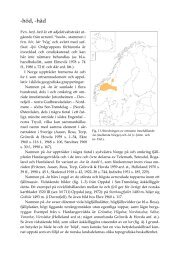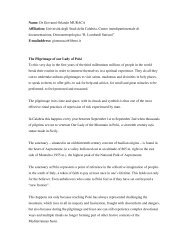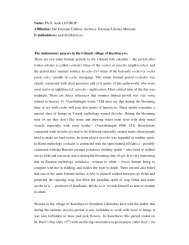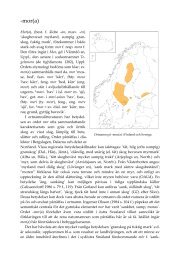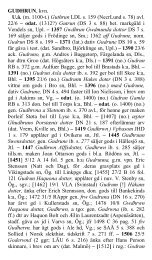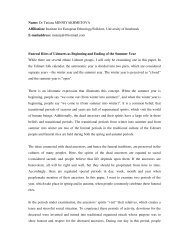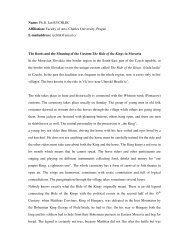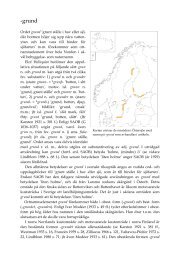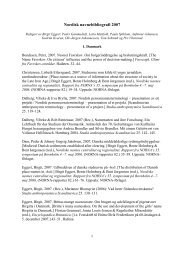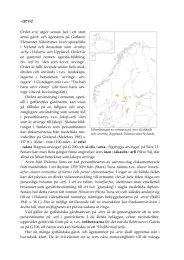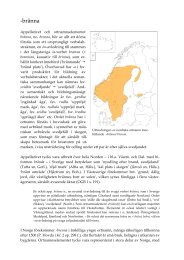NORNA-RAPPORTER 88 Binamn. Uppkomst, bildning, terminologi ...
NORNA-RAPPORTER 88 Binamn. Uppkomst, bildning, terminologi ...
NORNA-RAPPORTER 88 Binamn. Uppkomst, bildning, terminologi ...
Create successful ePaper yourself
Turn your PDF publications into a flip-book with our unique Google optimized e-Paper software.
Coming to grips with the multifacetedness of bynames 45<br />
(11) classification of names,<br />
(12) statistical onomastics and<br />
(13) lexicography of names.<br />
This selection of onomastic subdisciplines illustrates that onomastics, including<br />
the study of bynames, has not only the potential to meet challenges in collaboration<br />
with other disciplines but also to embrace a holistic approach.<br />
4. Which is the most essential facet?<br />
In view of the multifacetedness of bynames, the question arises which of the<br />
facets is the most essential. The answer, which complies with my third thesis,<br />
is simple if somewhat unsurprising – none. Integrated with the whole, each facet<br />
of the gem is important and interesting. A particular facet of the gem can,<br />
however, be the most essential one to look at for one’s present purposes. Looking<br />
at one facet after the other is as valid an approach as looking at the whole<br />
gem.<br />
5. Conclusion<br />
What does all that come down to? – The multifacetedness of bynames can<br />
neither be taken for granted nor as given. That is the reason why I have suggested<br />
that studying bynames is like gem cutting. Byname students take an active<br />
part in what they see and how they see it. They are gem cutters who cut and<br />
polish, that is, facet, rough gems. Now, that is the reason why I have suggested<br />
that there are no facets without faceting. If bynames students have focused on<br />
individual facets, this is at least in part do to with the fact that «the discrete exactness<br />
of parts is more important than the supposed vagueness of the whole»<br />
(Koch 1989, p. 239). Even though I have tried to sketch a picture of the whole,<br />
I do not consider the whole more important than its parts. Instead what is being<br />
propounded here is this: Byname students need to carry out more synthesising<br />
research to view their findings less in isolation and to position the study of bynames<br />
in the system of sciences. That is the reason why I have suggested that<br />
we cannot see the whole gem if we focus on the individual facets and that, on<br />
the other hand, there is no facet without a gem. That is what coming to grips<br />
with the multifacetedness of bynames is all about.<br />
References<br />
Bach, Adolf, 1952–53: Deutsche Namenkunde 1. Die deutschen Personennamen. 2<br />
vols. 2nd ed. Heidelberg.<br />
Brendler, Silvio, 2006: Grundlagen der englischen Zunamenforschung. CD-ROM.<br />
Hamburg.<br />
— 2007: Deskriptive Konnotationen versus motivationale Konnotationen. Zu zwei zentralen<br />
Komponenten der Wortbildungssemantik der Zunamen. In: Zunamen. Zeitschrift<br />
für Namenforschung/Surnames. Journal of name studies 2. Pp. 21–43.



